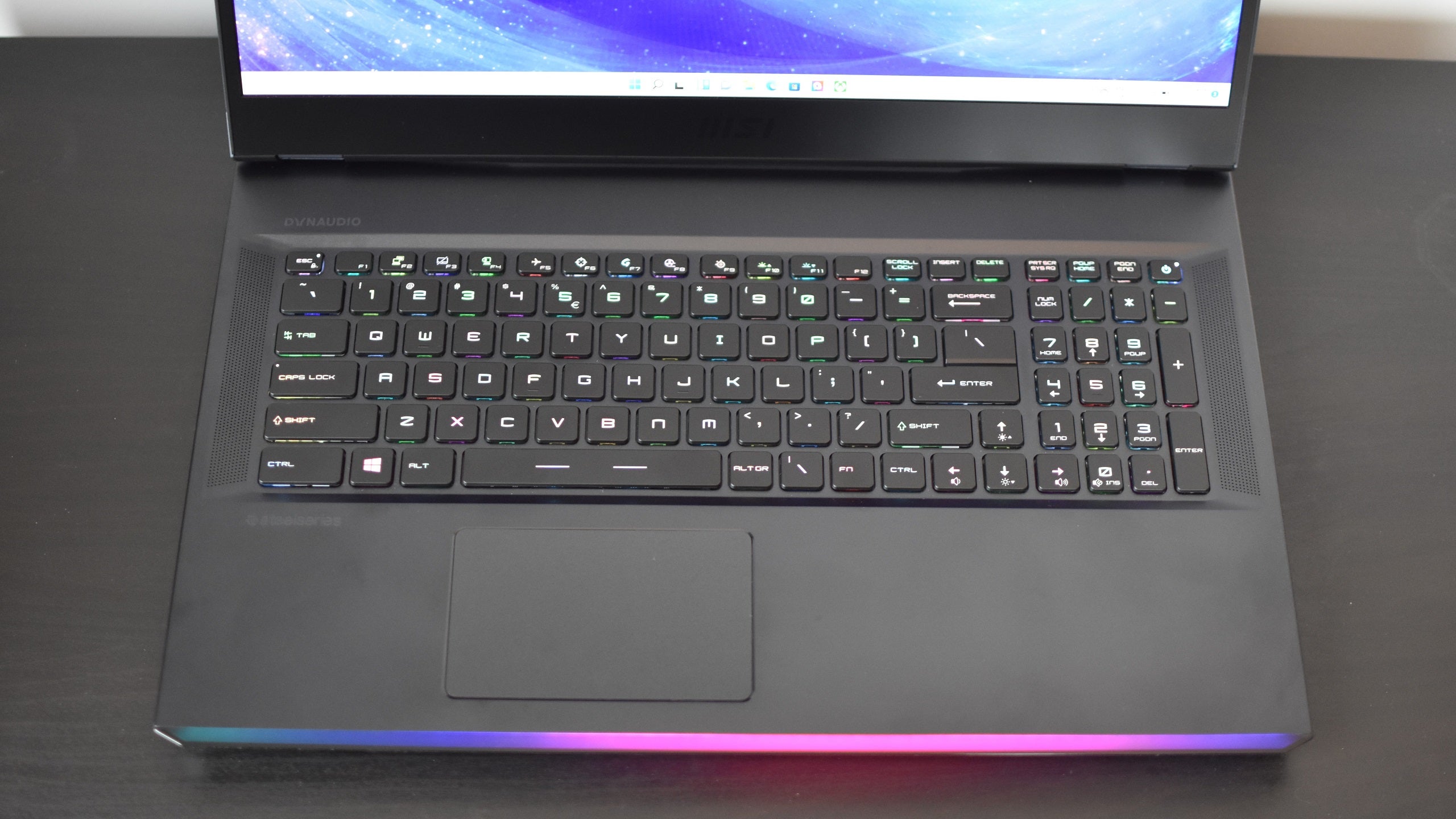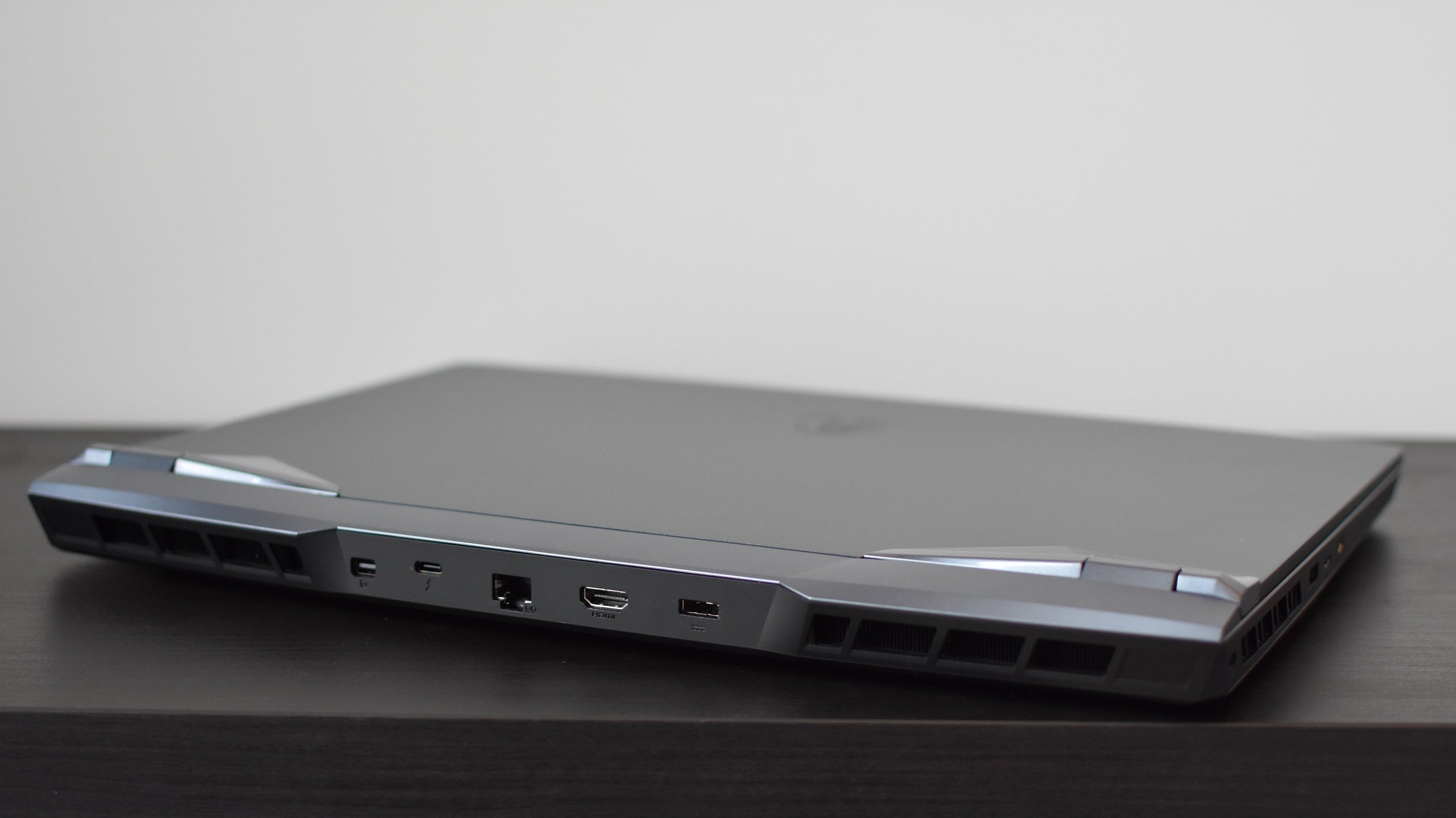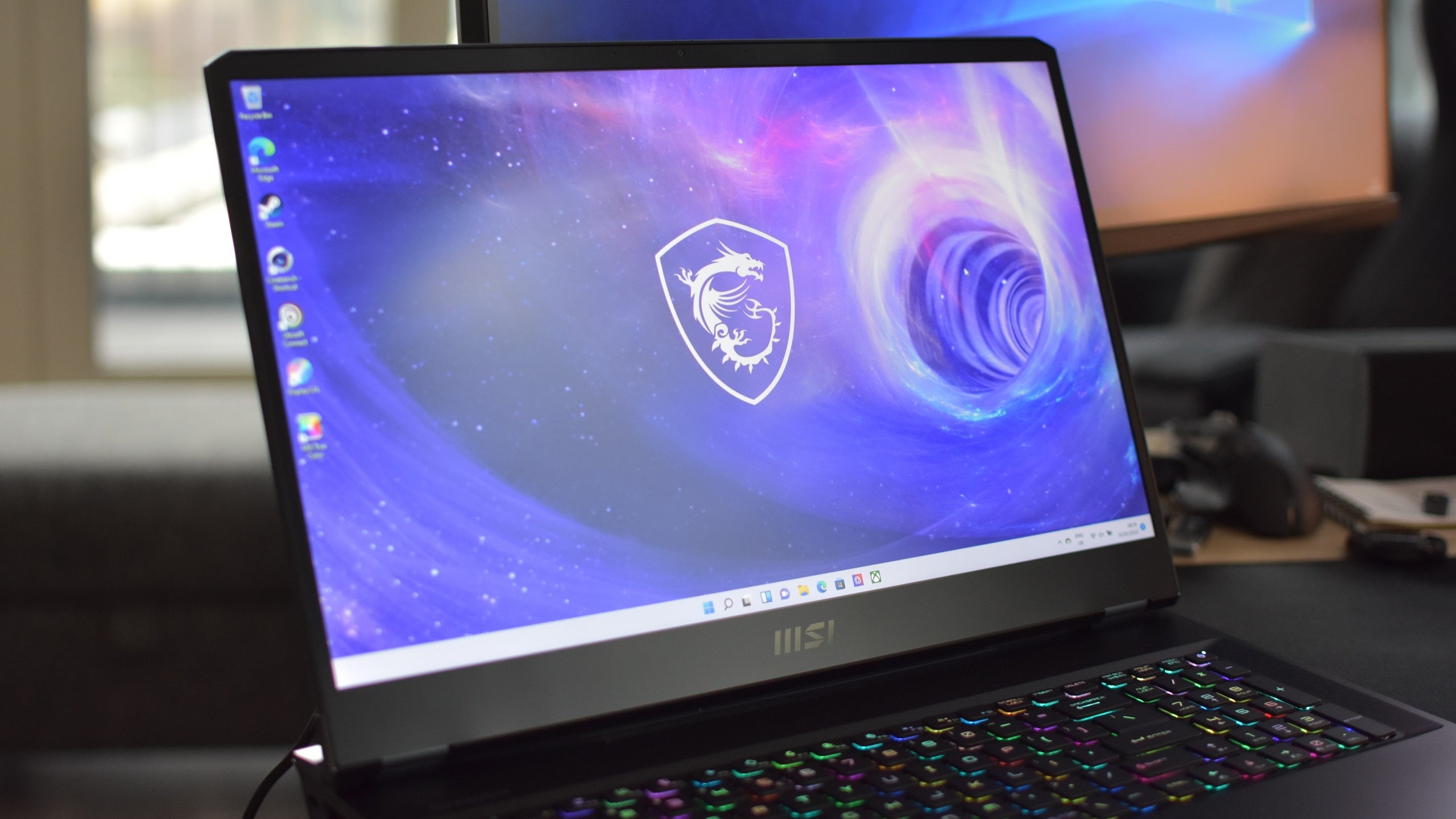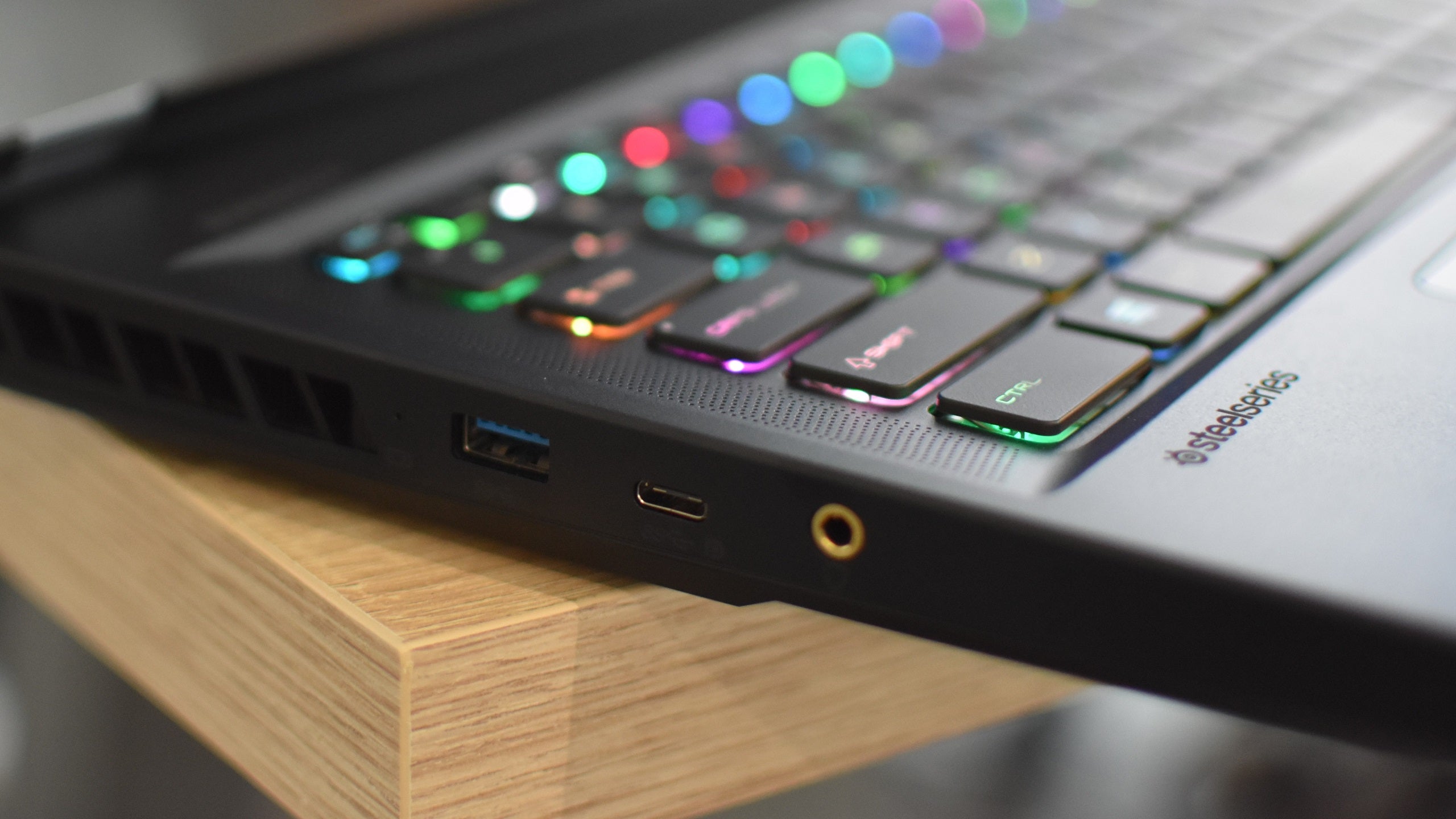Intel’s 12th Gen notebook processors and the mobile version of Nvidia’s GeForce RTX 3080 Ti are now finding their way into gaming laptops, after their respective reveals this January. And both have found their way into the MSI Raider GE76, that top-spec GPU getting paired with a fittingly top-spec CPU: the Core i9-12900HK.
The result is an enthusiastically exclusive laptop; so exclusive, it turns out, that I can’t find the exact model I tested on sale anywhere. Whelp! But to give you an idea of how overdraft-obliterating the Raider GE76 will be, its 4K/120Hz version (the one I used has a 1080p /360Hz screen) is £4400. That’s more than three RTX 3090s, or seven 512GB Steam Decks, with no reason to believe the 1080p version will go much lower than £4000.
Still, that’s not too surprising when you remember where the Raider GE76 came from: it’s basically a refreshed take on last year’s MSI GE76 Raider, and yes, the flipping-round of the name confused me as well. Yet outwardly, these two laptops appear identical: both measure a chunky 397x284x25.9mm and weigh 2.9kg, with copy/pasted styling and the exact same ports. I believe a different IPS panel forms the newer laptop’s display – more on that below – but the key specs of a 1920×1080 resolution and a 360Hz refresh rate match those of the GE76 Raider model I tested in 2021 as well.
In other words, the new Raider GE76 is all about those internal upgrades. And you can’t get higher-end than a Core i9-12900HK on the CPU side: it’s the overclockable, 14-core pinnacle of Intel’s latest laptop chips, with same hybrid core approach as 12th Gen CPUs like the Core i9-12900K and Core i5-12600K. These are two of the best CPUs for gaming you can get, so the Core i9-12900HK’s mix of six high-speed Performance cores and eight power-saving Efficiency cores puts it in good company.
Then there’s the RTX 3080 Ti, on paper the most powerful RTX laptop GPU in Nvidia’s arsenal. Its boost clock speeds are a little lower than those of the RTX 3080, but that’s probably because it’s crammed with nearly 1300 more CUDA cores, with 16GB of GDDR6 VRAM as standard. If there’s a mobile GPU that can fill out a 360Hz refresh rate, it’s this one.
The old GE76 Raider had both components’ last-gen equivalents, the Intel Core i9-11980HK and the RTX 3080, which at least makes for some easy comparisons. Starting with pure CPU power: in the Cinebench R20 benchmark, the Core i9-12900HK set a new RPS review record with 665 in the single-core test and 5690 in the multicore test. As the previous model’s Core i9-11980HK scored 619 and 5052 respectively, it doesn’t look like the hybrid core design’s gen-on-gen performance gains aren’t quite as substantial for mobile CPUs as they are for desktop chips, but that’s still a healthy improvement. As expensive as it is, the Raider GE76 will easily outpace older Intel and AMD laptops in both single applications and multitasking.

It’s harder to confirm Intel’s claim of 12th Gen chips enabling better battery life. The prevalence of smaller, less power-hungry Efficiency cores (or E-cores) in the Core i9-12900HK is a reason to hope, though the 2022 Raider GE76 could only run Shadow of the Tomb Raider for one hour and nine minutes. Yes, the GPU is more powerful, but that lifespan is only on par with the Core i9-11980HK model. Which is to say, equally short.
That said, if you want a laptop as stationary but space-saving desktop alternative, this CPU is an upgrade worth having. And the GPU is a decent successor to the RTX 3080 too: while the 2021 GE76 Raider averaged 65fps in Metro Exodus, on Ultra quality with DLSS and maximum ray tracing, the 2022 Raider GE76 averaged 81fps. That’s enough for a visible smoothness improvement on the 360Hz screen.

I still think, as I did with the last model, that refresh rate is higher than necessary; 144Hz would still look great, and reduce battery drain. But even if you’re not hitting 360fps, you’re usually getting a bit closer than on the RTX 3080. Highest-quality Final Fantasy XV proved to be one exception, as both laptops hit the game’s 120fps cap, but enabling TurfEffects and Hairworks gave the more powerful card an advantage. Frame rates landed within the 72-90fps range, up from 54-80fps.
Total War: Three Kingdoms and its Battle benchmark produced mixed results. The Raider GE76 averaged 104fps on Ultra quality and 145fps on High quality, while the GE76 Raider averaged 94fps and 85fps respectively. That’s a huge gain on High, but a relatively tiddly one on Ultra. Shadow of the Tomb Raider returned to normal service, with the newer laptop scoring 102fps in a Highest quality benchmark run (with SMAAT x2 anti-aliasing) versus the older model’s 85fps.
Overall, the RTX 3080 beats the RTX 3080 by enough of a margin to feel worthwhile, even it never truly embarrasses the lower-spec GPU. The fact that it will more consistently stay above 60fps in Ultra-quality AAA games is, alone, enough to make it a good choice for any high-end gaming laptop. Just remember that these results come when it’s matched with the most powerful laptop CPU as well, SO mileage may vary slightly on machines with Core i7s or AMD chips.

Happily, there are other, less obvious ways in which MSI has spruced up this particular notebook, and one is the display. I can only speak for the 1080p/360Hz model, not the 4K/120Hz or the 1440p/240Hz versions (the latter is also hard to find despite MSI’s own site confirming it exists), but there’s a marked brightness and contrast improvement. I measured its peak luminance at 276cd/m2 and its contrast ratio at 1168:1, both up significantly on the older laptop’s respective 184cd/m2 and 772:1. This comes at the essentially imperceptible cost of sRGB gamut coverage dropping from 90.4% to 89.7%, but I’ll take that sub-1% difference in exchange for brighter whites and deeper blacks any day.
MSI have upgraded the storage as well. You still get two NVMe SSDS, both 2TB on the spec I tested, but this time both use the faster PCIe 4.0 interface, rather than one using PCIe 4.0 and one using PCIe 3.0. The SSDs are also faster than the old GE76 Raider’s sole 4.0 drive, according to the AS SSD benchmark tool.Sequential read speeds were up from 4414MB/s to 5369MB/s, 4K random read speeds were up from 57MB/s to 79MB/s, and random write speeds were up from 169MB/s to 205MB/s. Only sequential write speeds went the opposite way, down from 3964MB/s to 3853MB/s, but three out of four ain’t bad.

In just about every other way, this is the same laptop as the GE76 Raider. It’s hefty but luxurious, with a well-spaced and firm-feeling mechanical keyboard, Thunderbolt 4 connectivity, and strong build quality (save for a slight flex to the screen). The webcam is unusually good, as are the speakers, and the only real concession to stereotypical ‘gamer’ design is the RGB light strip on the bottom edge. Which you can turn off.
The new CPU and GPU don’t create any thermal issues either. In fact, my decibel-o-meter recorded the fans at 43 decibels under load, which is slightly quieter than the older model – though still loud enough to require headphones.

Successfully and by design, the Raider GE76 fits into the same role that is predecessor is now vacating: that of the gaming laptop you buy when you’ve just got so much cash to burn that you might as well go for the best of the best. Whether it’s a sensible purchase is a different matter, and not just because the 1080p model is so damned hard to find, but that’s your call in the end. If the four grand price isn’t an instant dealbreaker, nothing else here will be.
Even if you never savour the Raider GE76 for yourself, though, it provides a valuable service by demonstrating what today’s best gaming laptop components are capable of. Performance-wise, the yardstick is down – now it’s time to see how more affordable hardware can measure up.
